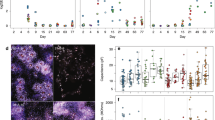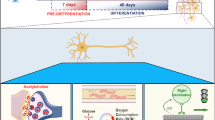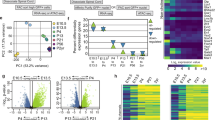Abstract
CELLS derived from the mouse neuroblastoma (C1300) grown in culture are predominantly round and highly refractile. A small number of the cells are flatter and possess one or more extensions (“neurites”) which may be as long as 3 mm1–3. The proportion of these morphologically differentiated cells increases when the medium lacks serum4 or when 5-bromo-deoxyuridine is added5. The cells also contain enzymes of neural function2,6 and are capable of generating action potentials in vitro7,8. We now show that differentiated characteris-tics of neuroblastoma cells can be induced by N6,O2′-dibutyryl adenosine 3′ : 5′-monophosphate (dibutyryl-cyclicAMP).
This is a preview of subscription content, access via your institution
Access options
Subscribe to this journal
Receive 51 print issues and online access
$199.00 per year
only $3.90 per issue
Buy this article
- Purchase on Springer Link
- Instant access to full article PDF
Prices may be subject to local taxes which are calculated during checkout
Similar content being viewed by others
References
Klebe, R., and Ruddle, F., J. Cell Biol., 43, 69A (1969).
Augusti-Tocco, G., and Sato, G., Proc. US Nat. Acad. Sci., 64, 311 (1969).
Schubert, D., Humphreys, S., Baroni, C., and Cohn, M., Proc. US Nat. Acad. Sci., 64, 316 (1969).
Seeds, N. W., Gilman, A. G., Amano, T., and Nirenberg, M. W., Proc. US Nat. Acad. Sci., 66, 160 (1970).
Schubert, D., and Jacob, F., Proc. US Nat. Acad. Sci., 67, 247 (1970).
Blume, A., Gilbert, F., Wilson, S., Farber, J., Rosenberg, R., and Nirenberg, M., Proc. US Nat. Acad. Sci., 67, 786 (1970).
Nelson, P., Ruffner, W., and Nirenberg, M., Proc. US Nat. Acad. Sci., 64, 1004 (1969).
Harris, A. J., and Dennis, M. J., Science, 167, 1253 (1970).
Puck, T. T., Marcus, P. I., and Cieciura, S. J., J. Exp. Med., 103, 273 (1956).
Kates, J. R., Winterton, R., and Schlessinger, K., Nature, 229, 345 (1971).
Pastan, L., and Perlman, R. L., Nature New Biology, 229, 5 (1971).
Ellman, G. L., Courtney, K. D., Andres, V., jun., and Feather-stone, R. M., Biochem. Pharmacol., 7, 88 (1961).
Hsie, A. W., and Puck, T. T., Proc. US Nat. Acad. Sci., 68, 358 (1971).
Johnson, G. S., Friedman, R. M., and Pastan, I., Proc. US Nat. Acad. Sci., 68, 425 (1971).
Gushing, H., and Wolbach, S. B., Amer. J. Pathol., 3, 203 (1927).
Author information
Authors and Affiliations
Rights and permissions
About this article
Cite this article
FURMANSKI, P., SILVERMAN, D. & LUBIN, M. Expression of Differentiated Functions in Mouse Neuroblastoma mediated by Dibutyryl-cyclic Adenosine Monophosphate. Nature 233, 413–415 (1971). https://doi.org/10.1038/233413a0
Received:
Revised:
Issue Date:
DOI: https://doi.org/10.1038/233413a0
This article is cited by
-
Effects of cyclic AMP and butyrate on cell cycle, DNA, RNA, and purine synthesis of cultured astrocytes
Neurochemical Research (1992)
-
Depolarization of the neuronal membrane caused by Co-transport of taurine and sodium
Neurochemical Research (1990)
-
Morphological differentiation of neuroblastoma cells induced by dimethylsulfoxide
Neurophysiology (1985)
Comments
By submitting a comment you agree to abide by our Terms and Community Guidelines. If you find something abusive or that does not comply with our terms or guidelines please flag it as inappropriate.



